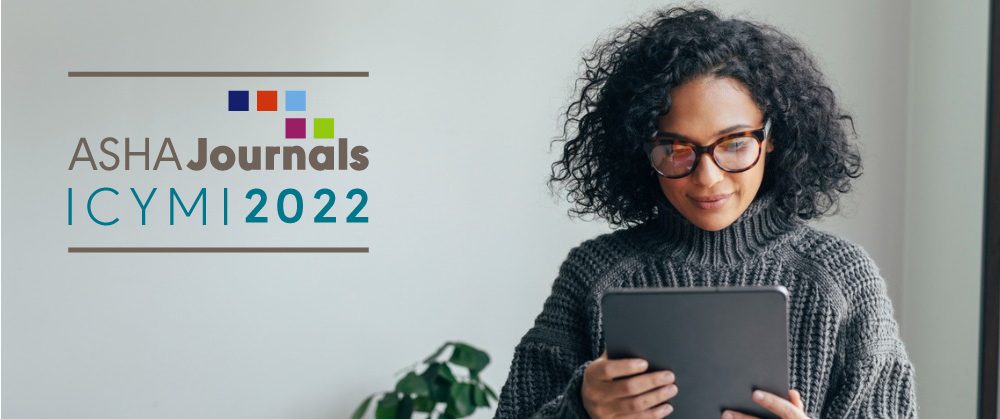2022 was a banner year for ASHA’s journals! Our overall readership hit a new record high, and we published 850 new articles across our five journals. Below, we’re highlighting some of our most popular and most talked about articles from across all five journals.
Our Most Read and Most Talked About Articles
Minimal, Maximal, or Multiple: Which Contrastive Intervention Approach to Use With Children With Speech Sound Disorders? Our most-read article of 2022 compares a familiar speech sound disorder intervention approach with two newer approaches. The tutorial can help guide clinicians to better pair an intervention with a patient’s specific needs.
Setting the Stage for Speech Production: Infants Prefer Listening to Speech Sounds With Infant Vocal Resonances: This study found that infants between 6 and 8 months of age greatly preferred listening to speech similar to their own—or, to put it more simply, baby talk. This was our most talked about article of the year, generating a lot of interest on social media, and was the subject of more than 40 news articles highlighting the unique findings.
Dysphagia and Swallowing
Dysphagia and Quality of Life, Participation, and Inclusion Experiences and Outcomes for Adults and Children With Dysphagia: A Scoping Review: This review article aimed to determine how both dysphagia and dysphagia interventions impact a person’s quality of life. Authors reviewed more than 100 studies for this article, which was our most cited article published in 2022!
Tutorial on Clinical Practice for Use of the Fiberoptic Endoscopic Evaluation of Swallowing Procedure With Adult Populations: Part 1: Since the 1980s, clinicians have been using fiberoptic endoscopic evaluation of swallowing (FEES) to evaluate swallowing function. This article provides updated best practice guidelines for clinicians who perform FEES in adults, including highlighting important training needs.
The Continued Impact of COVID-19
Evolution of Telehealth Technology, Evaluations, and Therapy: Effects of the COVID-19 Pandemic on Pediatric Speech-Language Pathology Services: Although it may seem that telehealth technology has been omnipresent since March 2020, some of the barriers to this technology—barriers that have existed for years—are still present. This article explores the perspectives of speech-language pathologists on the uptake in telepractice use and attitudes toward it since the onset of the COVID-19 pandemic.
Effect of Protective Face Coverings on Sentence Recognition in Noise for Cochlear Implant Patients: Even before the onset of the COVID-19 pandemic, protective face coverings were widespread and even required in many medical settings. This article studies the difficulties that people with cochlear implants have when listening to a speaker wearing a face covering.
Top Articles in Audiology
Sound Localization of Listeners With Normal Hearing, Impaired Hearing, Hearing Aids, Bone-Anchored Hearing Instruments, and Cochlear Implants: A Review: This review article explores sound localization abilities in people with normal hearing and those with hearing loss using a number of management techniques. The authors found that although hearing devices serve crucial purposes for their users, these devices have not been designed to preserve and replicate sound localization cues.
The Impact of Daily Hours of Sound Therapy on Tinnitus Relief for People With Chronic Tinnitus: A Randomized Controlled Study: Sound therapy is a great option for tinnitus rehabilitation and relief, but how much sound therapy is enough? This article compared the effectiveness of sound therapy for people receiving 1, 3, and 5 hours of therapy a day.
Communication and Language in Children and Youth
A Systematic Review and Meta-Analysis of the Language Skills of Youth Offenders: In this article, the authors found that regardless of age or gender, the language skills of youth offenders were significantly lower than the skills of their nonoffending peers. Researchers explore the role that language plays in academic and social environments—and offer recommendations for policy and practice.
A Systematic Review of Augmentative and Alternative Communication Interventions for Children Aged From 0 to 6 Years: Augmentative and alternative communication (AAC) can help children show improvements in expressive and receptive communication, communication participation skills, and more. This review summarizes the latest evidence regarding AAC use in young children with a variety of diagnoses.
And So Much More!
Thanks so much for stopping in to review 10 of our top articles from 2022! Representing just over 1% of what we published in 2022 alone, these articles are only a small sample of what the ASHA journals offer you.
If you’re looking for something specific, our topic collections are a great place to start. Choose a topic that interests you, and then use the date, journal, and even article type or author filters to find exactly what you want.
You can find the most recent, most read, and trending articles at the ASHAWire home page. And don’t forget: When you find something that interests you, go ahead and like and share it on social media!







